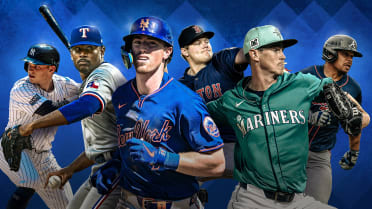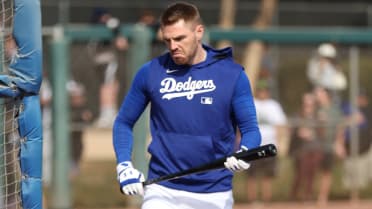I started covering prospects at MLB.com full-time back in 2003. It didn’t take long until I figured out that the quickest way to draw attention to our coverage was to start ranking prospects. On a fateful day 20 years ago, we launched our very first list, a Top 50 rankings of the top prospects in baseball at the time. Our very first No. 1 prospect? None other than newly elected Hall of Famer Joe Mauer.
Little did I or anyone else know just how far we’d come from that 2004 preseason list. We grew slowly at first, adding team lists (10 at first, then 20, before eventually building them out to 30) and expanding that initial Top 50 to 100 in 2012. We now run our Draft rankings out to 250 and also have boasted an international prospects list (now a Top 50) for more than a decade.
As we move into year 21 of prospect rankings with the 2024 Top 100 list, we figured it was a good time to do a little bit of a retrospective. Digging into 20 years of rankings is a huge, fun rabbit hole. Hope you enjoy the ride as much as I did.
Without being too self-congratulatory, these lists have been pretty darn predictive over the years. Heading into 2024, 85.3 percent of the 950 players who have appeared on a Top 50 or Top 100 have made it to the big leagues. And remember, there are a bunch of really good players from recent lists who simply haven’t gotten there yet. If you only consider players on lists prior to 2020, that percentage is 94.4.
Not shockingly, the higher the rank, the more big league success. Prospects who have been ranked in the 1-10 range have gone on to amass over 4,600 WAR, which is 2,000 more than prospects who have ranked 11-20. And that trend continues steadily as you move down each rung of 10:
1-10: 4,635.7 WAR
11-20: 2,636.8 WAR
21-30: 2,295.8 WAR
31-40: 2,356.6 WAR
41-50: 1,717.0 WAR
The same holds true for individual rankings as well. No. 1 prospects have compiled 606.5 WAR to date, leading the pack. And of the 10 ranking slots that have accumulated the most WAR, nine of them are Top 10 spots:
606.5 - No. 1
570.6 - No. 3
516.5 - No. 2
511.4 - No. 4
500.8 - No. 8
459.8 - No. 6
390.5 - No. 5
372.1 - No. 10
359.9 - No. 7
353.7 - No. 13
They’re No. 1
We've had a total of 17 preseason No. 1 prospects since we started on this path, with Mauer kicking things off and Jackson Holliday becoming the most recent member of the club as the game’s No. 1 prospect in 2024. Here are all of our preseason No. 1 prospects, ranked by bWAR, with the years they landed in the top spot in parentheses:
- Mike Trout (2011), 85.2
- Joe Mauer (2004), 55.2
- Jason Heyward (2010), 40.7
- David Price (2009), 40.3
- Shohei Ohtani (2018), 34.7
- Corey Seager (2016), 32
- Byron Buxton (2014-15), 21
- Jay Bruce (2008), 19.9
- Andrew Benintendi (2017), 16.1
- Vladimir Guerrero Jr. (2019), 15.2
- Wander Franco (2020-21), 11.6
- Matt Moore (2012), 8.8
- Gunnar Henderson (2023), 7.1
- Bobby Witt Jr. (2022), 5.3
- Jurickson Profar (2013), 5
- Delmon Young (2005-07), 3.2
- Jackson Holliday (2024), N/A
Beyond the top spot
Clearly, not every No. 1 prospect went on to have All-Star caliber careers. And it hasn’t always been the guy who ranked at the top who has gone on to have the most success in the big leagues. The highest career bWAR totals, with highest preseason ranking, are:
85.2 -- Mike Trout (No. 1 in 2011)
80.9 -- Justin Verlander (No. 5 in 2006)
79.9 -- Clayton Kershaw (No. 4 in 2008)
77.5 -- Zack Greinke (No. 4 in 2004)
64.5 -- Mookie Betts (No. 62 in 2014)
Betts moved up to No. 14 on the 2014 midseason list, making his Major League debut in late June that season, but that preseason ranking is worth pointing out. It turns out that the No. 62 has been a surprising sweet spot for our rankings. Take a look at this list of ranking spots based on bWAR per year in the big leagues.
No. 3 -- 2.69 WAR/yr
No. 2 -- 2.52 WAR/yr
No. 1 -- 2.48 WAR/yr
No. 62 -- 2.39 WAR/yr
No. 8 -- 2.26 WAR/yr
That’s right. No. 62 comes in fourth. Betts is obviously a huge reason, but he’s not alone. Nolan Arenado was No. 62 in 2013 and he’s gone on to amass 54.4 WAR. Trea Turner (33 WAR) was in that slot before the 2015 season. No. 62 has also been filled by Javier Báez in 2012 (26.6 WAR) and Max Fried on the midseason 2014 list (20.5 WAR).
Positional superiority
For years, we’ve put out a Top 10 by position and it’s always fun to put together a lineup, of sorts, of the top player at each position. This year’s roster is pretty impressive.
How about an all-time lineup? Here’s the best prospect at each position, again ranked by bWAR:
RHP: Justin Verlander, 80.9 (No. 5 in 2006)
LHP: Clayton Kershaw, 79.9 (No. 4 in 2008)
C: Joe Mauer, 55.2 (No. 1 in 2004)
1B: Joey Votto, 64.4 (No. 34 in 2008)
2B: Mookie Betts, 64.5 (No. 14 in 2014 midseason)
3B: Evan Longoria, 58.6 (No. 16 in 2007)
SS: Manny Machado, 54.9 (No. 6 in 2012)
OF: Mike Trout, 85.2 (No. 1 in 2011)
Anyone who sees those positional lists knows how deep some are. Typically right-handed pitchers, outfielders and shortstops are filled with Top 100 guys, often Top 50. Looking at which positions have had the most representation and gone on to accrue the most WAR, then, isn’t all that surprising.
RHP -- 883 (4,203 WAR)
OF -- 671 (4,150 WAR)
SS -- 447 (3,816 WAR)
LHP -- 290 (1,706 WAR)
3B -- 211 (1,510 WAR)
C -- 208 (980 WAR)
1B -- 96 (646 WAR)
2B -- 94 (600 WAR)
Organizational strength
Good farm systems lead to winning teams. It’s not just a theory. Teams ranked at the top of our farm system rankings (started in 2015) have gone on to win championships soon thereafter. Even teams that didn’t win it all have had postseason success fueled by a strong pipeline of talent. There’s more to measuring an organization’s strength than looking at how many prospects hit our rankings, but it’s not a terrible place to start. It shouldn’t surprise anyone that the Rays and Dodgers, long thought to be the standard bearers of continuously strong systems, lead the list of most Top 100 prospects since 2004 (overall):
137 -- Rays
131 -- Dodgers
127 -- Pirates
125 -- Padres
120 --Twins
This gives organizations credit for a guy who was on a list multiple times. Byron Buxton, for instance, was our No. 1 prospect on five straight rankings. Even if you do it based on one player only counting once, it’s still the same teams at the very top:
46 -- Dodgers
41 -- Rays
40 -- Rangers
39 -- Red Sox
36 -- Cubs, D-backs, Mariners
How good have these prospects gone on to be in the big leagues? The Dodgers are still the cream of the crop in terms of most bWAR accumulated by Top 100 prospects:
283 -- Dodgers
277.2 -- Braves
270 -- Red Sox
237.1 -- D-backs
230.2 -- Royals
All of these lists should have a “to be determined” or “incomplete” asterisk, of course. So many of the players included in this snapshot are still very much in their prime, and many of these rankings will look different as the years unfold and more young stars reach the big leagues for the first time. Can’t wait to update everyone when we get to future milestone anniversaries.
Jonathan Mayo is a reporter for MLBPipeline.com. Follow him on Facebook and @JonathanMayo, and listen to him on the weekly MLB Pipeline Podcast.




